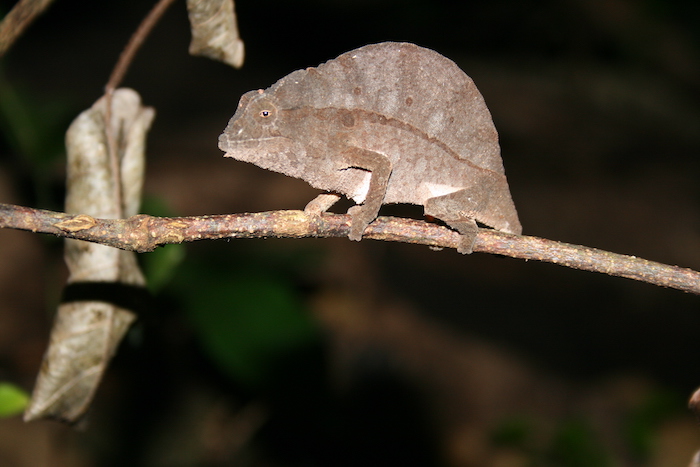The elevation and isolation of Tanzania’s Rondo plateau has shaped a landscape of misty forest fragments, packed with little-known life. This week, we’ve been showcasing miniature specialists you can help protect through our ‘Saving Tanzania’s Coastal Forests’ appeal, like the Rondo Bushbaby and the Chequered Elephant Shrew. Today, it’s time for you to meet a chameleon that could fit in the palm of your hand – an illusionist whose home needs your help.
If yesterday you read part two of our series and you thought Chequered Elephant Shrew were hard to spot, today you will find that our next featured tiny specialist takes evasion to the next level.
Another resident of the coastal forests our partner Tanzania Forest Conservation Group (TFCG) can protect – with your help – this year, Africa’s Bearded Pygmy Chameleon are an extremely difficult species to catch sight of in the wild.
Part of it is, of course, the colour-changing ability so trademark of a chameleon: the spectrum of browns, yellows, greens, oranges and blacks this species can adopt to attract a mate, show stress and others.
But there is also size: a full-grown Bearded Pygmy Chameleon is not just tiny – at 8 cm, their length would see them fit into the palm of an adult human hand – but can also make itself even tinier. When sleeping out in the open, this species can fool predators by compressing its body and producing a stripe down its side to mimic a dead leaf; earning them their alternative name Bearded Leaf Chameleon.
Every tree counts: Saving the home of slow-moving chameleons
As helpful as they prove against predators, illusionist tricks cannot help the Bearded Pygmy Chameleon against a bigger threat: its reliance on habitats outside of which it struggles to live.
Maps from the International Union for Conservation of Nature (IUCN) place the Bearded Pygmy Chameleon across a large swathe of eastern Tanzania and Kenya. However, as conservationist Andrew Perkin explains, actual numbers on the ground are low and restricted to well-preserved coastal forests, where they seek out insects from the shrub layer about half a meter off the ground.
“At night we can sometimes see them because they are frozen still next to the stem, and their colour is pale so we can find them but overall there are very few Bearded Pygmy Chameleon populations in the coastal forests because just like the Rondo Galago, they need this moist microclimate to survive – as soon you walk 20 meters away from the forests you won’t see them,” Andrew says.
Flap-necked Chameleon, found across Africa, are the third most trafficked chameleon species. This one was photographed by primatologist Andrew Perkin during a visit to Tanzania’s coastal forests. Credit: Andrew Perkin.
In Tanzania, the Bearded Pygmy Chameleon is not the sole representative of this Old World lizard family. This tiny illusionist shares the coastal forests with the Flap-necked Chameleon, a much larger species – at a length of 35cm, they are slightly longer than an A4 sheet – that lights up the forest with its bright colours.
An insectivore forest dweller, the Flap-necked Chameleon can shoot its tongue out as far as the length of its own body to catch prey, as well as rotating their eyes to give them a 360-degree view. Native to Madagascar, they are also found across mainland Africa and are the world’s third most trafficked chameleon species – a threat you can help them against this year.
This week we’ve introduced you to three tiny specialists whose fate is inextricably linked to habitats like the coastal forests of Tanzania.
The Rondo Bushbaby primate, the Chequered Elephant Shrew and the Bearded Pygmy Chameleon – all rely on the moist microclimate of forest fragments such as those found all over the Rondo Plateau. If we don’t intervene now by supporting our partner TFCG’s plan for 10 reserves and commercial farming continues expanding, local populations of this species might not have another habitat to flee to.
Donate to our appeal today – help us save the endemic, extraordinary life of Tanzania’s coastal forests!

